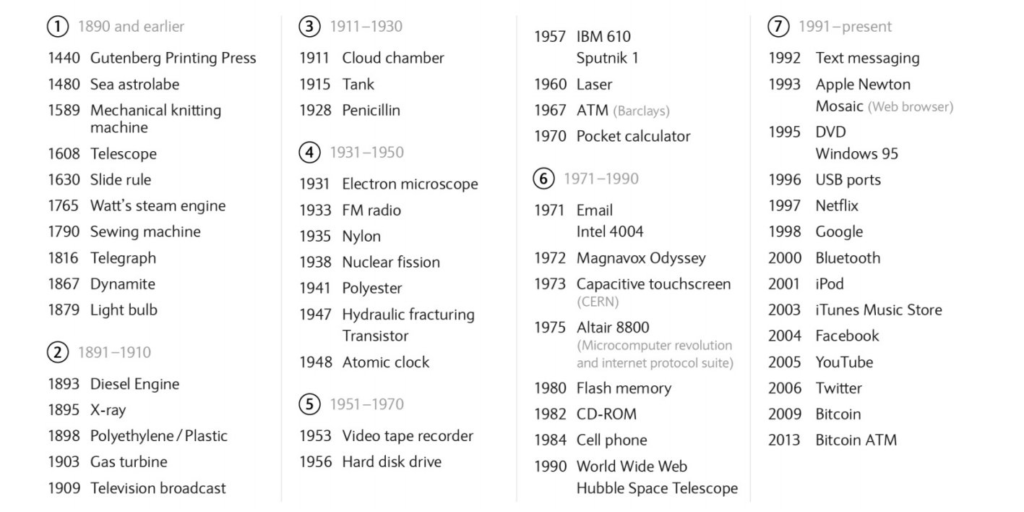The Next Industrial Revolution? Maybe. A simple test from 1950 will tell us soon enough. And if so – what will all the jobless doctors, lawyers and programmers do? Here’s one suggestion.

“Siri, are you going to take my job?”
“I’m sorry, I do not want to answer this question. Is there anything else I can do for you today?”
Technology is essentially a boost in efficiency. What was done with more (time and resources) – can now be done with less. Need to make a copy of a book? Months for a scribe, seconds on a printing press. Need to go from Rome to New York? Weeks by boat, hours by plane. If the change is big enough – in breadth and depth (number of people affected and the amount of resources saved) – the technological improvement can be considered a revolution * .
* It works the other way as well. If a technological improvement is not big enough - the companies providing it will fail. People do not change habits for a small improvement. Sure - mini-disks are small, do not skip and can record compared to CD-ROMs, but… I’ll wait for the iPod.The time “freed” also means the people paid for that time (their labor and acquiring their abilities) are now also becoming “free”. Which is a nice way of saying “out of a job”. On the sunny side – new jobs are also created. If the technology is fundamental enough – whole new ecosystems. Think travel, computers, internet.
When the change is gradual – professions will die at the pace their occupants retire or manage a career shift. When the change is too rapid – social turmoil might result (through growing inequality between those with capital and those relying on their labor). Dark times in history are attributed to changes like that – so let’s hope we are not facing one.
Now that I have your attention and your night’s sleep, let’s discuss AI. How are we going to know if it is “a revolution” or just “a rave”? What major new professions/ecosystems will appear? Is big money going to be made in brave new ways?


How to know if AI is really A revolution
We have short memory and never listened in history class.
Otherwise it is hard to explain the cries “stop AGI before it is too late!” and “stock NVIDIA chips under your mattress!” when we should be actually murmuring “AI again? Really?”. AI was raved as going to change the world as early as the 1950s. And then the 1960s, skipped the 70s, back in the 80s, reappeared in the 90s, then the 2000s and finally now. Sure – “this time it is different” – because of the new algorithms, the amount of data and computer power like never before. But is it really? We do not see mobs of doctors, lawyers, teachers and programmers breaking into server farms with burning torches, markers, stethoscopes and keyboards.

Alfred Pennyworth
So how can we know? Luckily – there is a test from 1950. Turing Test. If the current AI will pass it – a major change will probably follow. The Turing Test requires that a human talking to a hidden “thing” cannot tell the difference between an answering machine and an answering person. When that happens – according to the test – the machine will be deemed “intelligent”. I would take it a step forward – if any person will have a conversation with the “thing” and will not be able to tell if the other side is a knowledgeable person or machine – we have arrived. Why ‘any’, ‘conversation’ and ‘knowledgeable’? Since without expert, refinement and truth – there is no real value.
Are we there? Not yet. And a new AI winter might arrive before we get there. The amount of data, the computer power, the algorithm – they might not be ready. AI will be a nice feature – like search auto-complete, personalized feed and ad algorithms. They are useful, they generate a lot of money – but they are no social revolution. Remember “Deep Blue”.
AGI and a Paperclip Apocalypse are really out of the question. The algorithms are not even aiming there (we do not know where to aim). “Hoping” intelligence will spontaneously “emerge” from a Turing Test is a bit (pun intended) naive. Maybe if we sprinkle a little Dopamine over the GPUs…
But let’s imagine the Turing Test will be passed in a year from now. That a medical doctor will be able to have an in-depth medical discussion with a “thing” and will not be able to know if it is a machine or a peer. That a machine will actually make fewer mistakes than a human giving a diagnose and treatment recommendation. It will be able to teach you Japanese while you commute. You will be able to describe what a software should do and it will be up and running on your device.
At that point – studying for years, laboring and charging hundreds of dollars per hour per human – will stop making sense for these professions. But that is only one half of the Turing equation.
The person having the questions – the need for the diagnosis, the legal consulting, the idea for the software, desire to learn or travel to a foreign country – is still there.
These are all different tasks. And these tasks are performed for different people with different tastes, at different times. An Australian surfer in her 20s is not the same as a retired Japanese engineer – even if both are asking to get travel suggestions.
Enter Companion Design.
What is Companion Design?
“Brahhhhh! Surf’s up on South Beach! Rolling 60 to one! Want me to text Gonzo and Frenchie to see if they’re down?”
“True, the collection at White is more Dada than Blaue Reiter but I think you will find it interesting. Would you like me to give you a quick overview of the works and why bringing them together is intriguing?”
“Nan! You want me to teach you Japanese with a focus on Manga? You will need a lot of Dokonjou, but ok. Ganbatte!”
When the AI passes the Turing Test – we will want to interact with it like we do with people. And as we (different people) interact with different people in different ways – so is our wish going to be. We will want our Travel Companion to match our preference for extreme winter sports and have our back in terms of guides, gear, insurance and weather. We would prefer that it knows what is the difference between Frame, Plate, Rail and AT Bindings without us needing to “refine”. And in the context of work – we assume it knows what DAU, CTR and CLTV are and will use them in the right context.
In other words – we want our AI Companions to be “Culturally Attuned”. And someone will need to create these Companions. The AI will not be able to guess who you are and how you prefer to interact in every context.

Skills required for Companion Design
Companion Design will be a mix of Product Management, Product Design, Psychology, Sociology, Cultural Studies and Art. It will be the profession of building a character for the machine.
Fine-tuned Companions will be able to chaperone users through their tasks – in a way that will be effective and enjoyable. This is where all the above abilities will come into play. An interesting twist in the history of human education – the humanities taking front stage again.
Since there are many subcultures and each person belongs to multiple at any given time (a technical person at work can have a very specific taste in music and fashion) and move between them as time passes (picking new and advancing in hobbies, changed tastes, trying new things, changed family status, career) there will be great deal of characters to be expressed.
Tools required for Companion Design
First – there will be the source. Vast pools of data. Some Objective (such as the internet) and some Subjective (such as our chats, emails, photos, interests in social media, where we go and what we see).
Then – The Companions will need to be able to connect to these pools – and they will do it through the AI gateways. These gateways – which today go by names such as ChatGPT, Gemini, Claude, Meta AI, Siri (kidding. But probably something new in June) – are what makes sense of the unstructured data they are fed with.
Then – There will be Companion or Character Building Tools (conveniently both abbreviate to CBT) – similar to today’s UI design tools (Figma, Sketch). They will allow “designing” the character of the Companion. The language, jargon, slang, attitude – and the knowledge it will draw its assistance from.
Finally – the Companions will need to be deployed in the wild.
- They will become part of existing tools – Fashion, Travel and Politics Companions in Instagram and Twitter.
- Will be tailored to specific enterprise needs – the know-all Toyota engineer at the manufacturing floor of the South Africa factory.
- Will “ride” on top of Objective mixed with Subjective sources – your family digital-doctor, your marathon trainer, your geography tutor, your stylist, your dating counselor, your planting optimization guide.
- Will be stand alone Companions – someone to talk with, without judgment or demands.
Operating these tools (assisted by worker AIs making the technical tasks conversational) are the Companion Designers. They will understand the human need, build the character of the companion to answer it and connect it to the sources it requires in order to succeed in its job.
Show me the money!
To keep the Companion Agent “clean” from commercial intent (unlike paid search results) – it cannot have interested parties skew its conversation with the user. But that does not mean it cannot make money. To achieve both – it needs to “close” the money-deal “after” the recommendation was made (where to go on vacation, which flight to book, what clothes to buy, which apartment to rent).
Might sound a little time-travel-ish, but there is actually a company operating in a similar way. Amazon. Under certain conditions Amazon does not care what a referred visitor purchases (so the referrer can be completely neutral). It is making money from everything so it is paying the commission regardless. In Amazon’s case it is simple – they are the everything store, but the world is still a bit larger then their warehouses. So how will the Companions make money?
They will register as ad-hoc affiliates. Each time they refer to a business – they will negotiate through the processing company and attribute the referred customer to them. Without closing the deal in advance or having “preferred merchants” that the Companion is working with.

Think of it as a hotel concierge. The ones that really care to get to know their customers’ preferences. Then give the perfect personalized recommendation. They call ahead to book and just before they hang-up – they ask the venue to put their name next to that of the customer. “Referred by Mr. Concierge”.
They will come to collect later.
It’s a wrap. Turing, Companions, Money
If AI passes the Professional Turing Test soon, we will need to be able to give it character. Character relevant to customers in context of their varied needs. It will be designed by humanities professionals, members of a new craft that understands people, needs and culture. It will give amazing value while making big money for its creators.
The future is not so dark after all.
But first we have a small test to pass. If we fail we are back in the fridge – right next to the blockchain jar.
